Different xylogenesis responses to atmospheric water demand contribute to species coexistence in a mixed pine-oak forest
Marín Pompa-García·J.Julio Camarero·Michele Colangelo
Abstract Seasonal patterns of wood formation (xylogenesis) remain understudied in mixed pine-oak forests despite their contribution to tree coexistence through temporal niche complementarity.Xylogenesis was assessed in three pine species (Pinus cembroides,Pinus leiophylla,Pinus engelmannii) and one oak (Quercus grisea) coexisting in a semi-arid Mexican forest.The main xylogenesis phases (production of cambium cells,radial enlargement,cell-wall thickening and maturation) were related to climate data considering 5-15-day temporal windows.In pines,cambium activity maximized from mid-March to April as temperature and evaporation increased,whereas cell radial enlargement peaked from April to May and was constrained by high evaporation and low precipitation.Cell-wall thickening peaked from June to July and in August-September as maximum temperature and vapour pressure def icit (VPD) increased.Maturation of earlywood and latewood tracheids occurred in May-June and June-July,enhanced by high minimum temperatures and VPD in P.engelmannii and P.leiophylla.In oak,cambial onset started in March,constrained by high minimum temperatures,and vessel radial enlargement and radial increment maximized in April as temperatures and evaporation increased,whereas earlywood vessels matured from May to June as VPD increased.Overall,15-day wet conditions enhanced cell radial enlargement in P.leiophylla and P.engelmannii,whereas early-summer high 15-day temperature and VPD drove cell-wall thickening in P.cembroides.Warm night conditions and high evaporation rates during spring and summer enhanced growth.An earlier growth peak in oak and a higher responsiveness to spring-summer water demand in pines contributed to their coexistence.
Keywords Bimodal growth·Drought·Vapour pressure def icit·Wood formation·Xylem phenology
Introduction
In extratropical biomes across the northern hemisphere,PinusandQuercusspecies are major forest components and provide multiple ecological and economic services (e.g.,timber,fuelwood,resins,fodder,food sources,habitat for wildlife).In Mexico and the continental United States,these species coexist in many seasonal drought-prone areas (Cavender-Bares 2016).These mixed pine-oak forests are still understudied in Mexico (but see Martin et al.2021),where 39% and 41% of the worldwide pine and oak species,respectively,have been described as endemic (Farjon and Styles 1997;Gernandt and Pérez de la Rosa 2014;Hipp et al.2018).Therefore,a better understanding is needed of the mechanisms driving the coexistence of pine and oak species in seasonally dry,diverse regions across Mesoamerica such as northern Mexico.
Pine-oak forests are some of the most vulnerable ecosystems to the impacts of climate warming (Galicia et al.2015),which is predicted to increase the severity of seasonal droughts in Mexico through increased evapotranspiration rates (Seager et al.2 009).Sympatric pine and oak species present physiological adaptations to seasonal water shortages contributing to their coexistence by using water in different periods or by taking it from different soil depths (Aguilar-Romero et al.2017;Fallon and Cavender-Bares 2018).For example,in Mediterranean sites,oaks tend to exploit deeper soil water sources than coexisting pines during summer droughts (Del Castillo et al.2016).In the case of oaks,niche partitioning among closely related species has been linked to trade-offs between drought avoidance or tolerance (desiccation recovery) and growth rates (Fallon and Cavender-Bares 2018).For instance,oak species from arid areas had more deciduousness and higher water-use efficiency than oak species from humid sites (Aguilar-Romero et al.2017).Other studies also found that oak species with higher drought tolerance inhabited low elevation,xeric sites (Martin et al.2021).Overall,drought severity affects the distribution and coexistence of pine and oak species in Mexico.
Fluctuating harsh conditions contribute to explaining coexistence in diverse forests (Chesson and Huntly 1997).Drought seasonality and severity may drive resource availability through time leading to different radial growth and xylem phenology (xylogenesis) patterns as observed in diverse dry tropical forests (García-Cervigón et al.2019).Variable intra-annual growth responses to drought among co-existing tree species can contribute to diversity maintenance through temporal niche complementary (Schwinning and Kelly 2013).To determine if differences in growth sensitivity to drought affect temporal resource heterogeneity and coexistence of pine and oak species,detailed analyses on xylogenesis as related to climate are needed.
Semi-arid and arid forests are strategic sites for developing xylogenesis studies because seasonal water shortages exert a key control over tree radial growth and carbon fixation (Pasho et al.2012;Martín-Benito et al.2013;Ziaco et al.2018;Zeng et al.2020;Morino et al.2021).Shifts in drought severity differentially impact trees,related to their ability to adjust to changes in soil moisture availability (Vieira et al.2020).Therefore,northern Mexican pine-oak forests and nearby regions subjected to seasonal water changes driven by summer monsoons,are ideal settings to disentangle the impacts of intra-and inter-annual climate variability on xylogenesis (Szejner et al.2020;Pompa-García et al.2021a,2021b).In similar seasonally dry forests subjected to high evapotranspiration rates,low and variable precipitation,and cold winter temperatures,xylogenesis was constrained by early growing season water availability (Camarero et al.2010;Ren et al.2019).
In this study,xylogenesis data was analyzed over a complete growing season for three pine species (Pinus engelmanniiCarr.,Pinus cembroidesZucc.,Pinus leiophyllasubsp.chihuahuana(Engelm.) E.Murray) coexisting with an oak species (Quercus griseaLiebm.) in a Mexican forest under semi-arid conditions.The goals were:(1) to determine the seasonal dynamics of xylogenesis;(2) to assess the climatic drivers of xylogenesis by relating wood-formation phases with climate data;and,(3) to discern if different xylogenesis responses to seasonal climate,particularly to drought,explain the coexistence of tree species.It was expected that species showing lower climatic constraints in their major growth phase,radial cell expansion (cf.Vaganov et al.2006),under water demand would be those with the highest drought tolerance.This would be the case ofP.leiophyllawhich inhabits semi-arid sites,whereas less tolerant species such asP.engelmanniiwould have the highest correlations between wood formation and atmospheric water demand.Strong responses of vessel radial enlargement to water demand were also expected forQ.grisea,given the strong stomatal regulation of water loss during drought that oaks from semi-arid sites tend to show (Fallon and Cavender-Bares 2018).
Material and methods
Study site
The study area was a 1.6-ha stand located near “Río Chico” village (23.92° N,104.87° E,2131 m a.s.l.) in Durango,northern Mexico (Fig.1).Five mature,healthy trees per species were sampled.We considered three pine species (P.engelmannii,P.cembroides,P.leiophyllasubsp.Chihuahuana-hereafterP.leiophylla) and one oak species (Q.grisea).These species are representative of diverse,mixed pine-oak forests dominant across drought-prone areas of the Sierra Madre Occidental in northern Mexico,and provide multiple environmental goods and services to local communities (Farjon and Styles 1997;González-Elizondo et al.2012).The climate is seasonally dry with monsoonal summer rains.The mean annual temperature is 15.5 °C and the average annual precipitation is 550 mm.Mean temperature during the study period (March 2019-March 2020) was 18.7 °C,total precipitation 361 mm and mean monthly evaporation 278 mm (Fig.2).
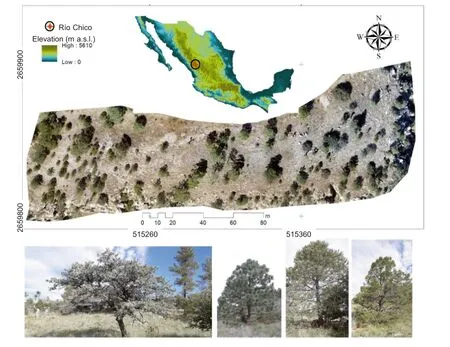
Fig.1 Location of the study site (Río Chico) in northern Mexico (red star),aerial view of sampled stand and images of the study’s oak and pine species
Climate data
Daily climate variables were recorded in the nearby “Río Chico” climatological station located 5 km from the study site:Tminand Tmax,minimum and maximum temperatures,respectively;precipitation;and evaporation.The differences between precipitation and evaporation (Prec.-Evap.) were calculated as a surrogate of available soil moisture.Vapor pressure def icit (VPD) was calculated from air temperatures and vapor pressure to estimate evaporative water demand,following Grossiord et al.(2020).
The warmest and coldest months during the period were June 2019 (mean maximum temperature of 31.1 °C) and January 2020 (mean minimum temperature of 3.9 °C).The months with highest and lowest evaporation values were May 2019 (474 mm) and November 2019 (146 mm).The year 2019 was dry with a total precipitation of 299 mm.Soils on the site are shallow,leading to low productivity and open stands (Fig.2).
Tree species
With regards to the characteristics of the study species,the Apache pine,P.engelmanniiinhabits mountain sites;it regenerates after low-intensity fires and its growth is constrained by warm,dry conditions in winter and spring (Bickford et al.2011;González-Casares et al.2016).P.cembroides,the pinyon pine,is native to the mountains of Mexico and southwestern USA where it occupies transitional zones between semi-arid plateaus and montane areas with rocky,poorly developed soils (Farjon and Styles 1997).This species is also sensitive to drought in winter-spring and to low winter temperatures (Carlón Allende et al.2018;Herrera-Soto et al.2018).The Chihuahua pine,P.leiophylla,develops well in the study site and it is tolerant to drought and wide thermal ranges,being distributed in semi-arid sites across the southern USA and northern Mexico (Acosta-Hernández et al.2019).However,this species is considered sensitive to climate warming (Galicia et al.2015).Lastly,Q.grisea,the grey oak,is distributed from central Mexico to southwestern USA and is codominant in Madrean pine-oak woodlands and in formations withP.cembroidesandJuniperusspp.(Little 1950).It may grow as a single stemmed tree to a multi-stemmed shrub form,with evergreen ordrought-deciduous leaves,depending on winter precipitation (Aguilar and Boecklen 1992).This species has considerable tolerance to wilting and a low tolerance to cold damage,making it a species suited for surviving prolonged summer drought stress (Fallon and Cavender-Bares 2018).
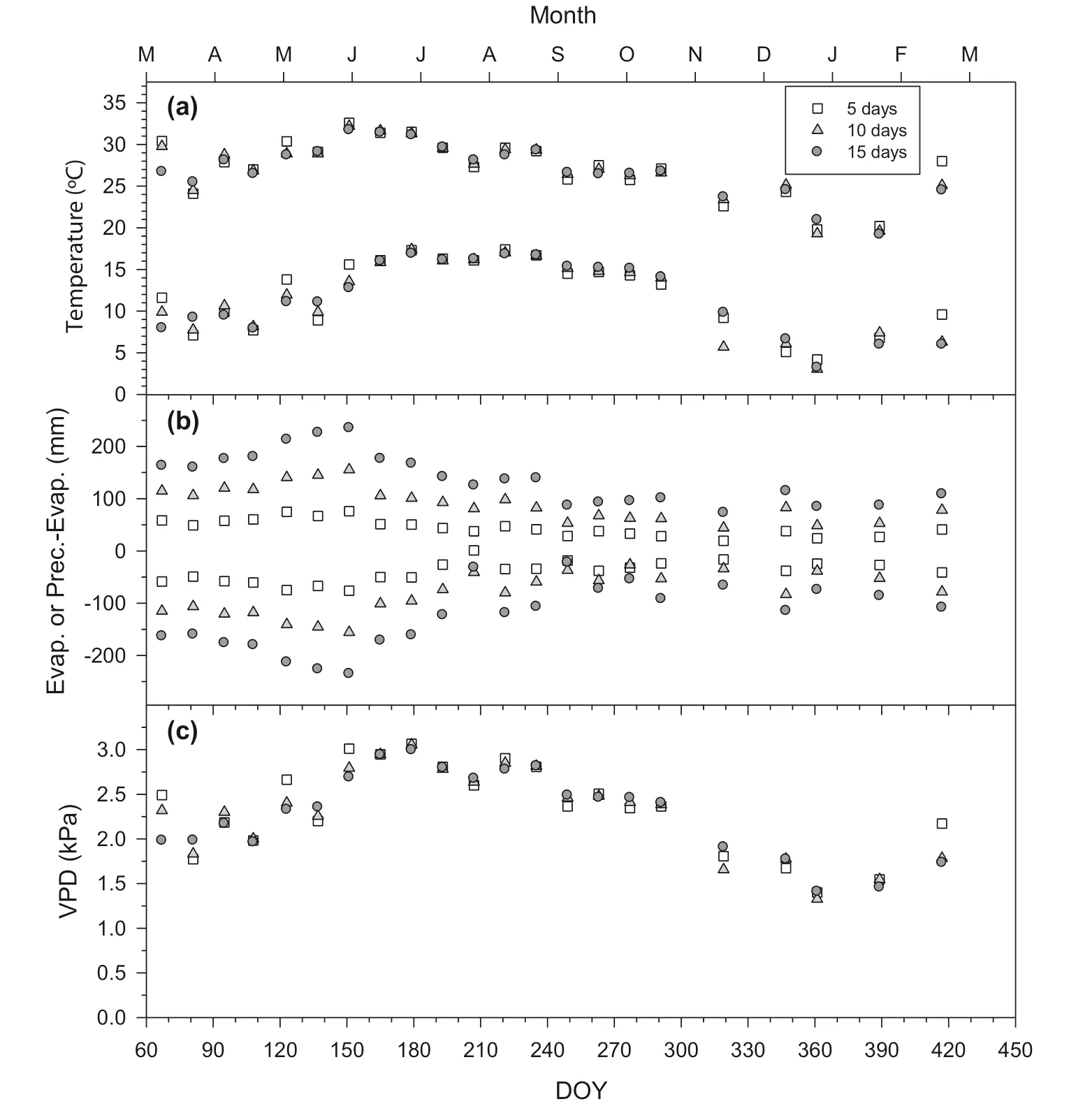
Fig.2 Climate data for the study site and during the monitoring period (March 2019-March 2020;DOY,day of the year) averaged (minimum and maximum temperatures,VPD) or summed (evap.,evaporation;prec.-evap.,difference between precipitation and evaporation) for 5-,10-and 15-day periods; a temperature,b evaporation (positive values) and differences between precipitation and evaporation (negative values),and c vapour pressure def icit (VPD)
Xylogenesis:analyses of wood formation
Since obtaining xylogenesis data is highly time-consuming,it was considered that five mature trees per species would be sufficiently representative.Similar approaches have been used in other xylogenesis studies (e.g.,Rossi et al.2006).To assess xylogenesis,wood microcores (2 mm diameter and 15-20 mm length) were taken biweekly (16-day intervals) from March 2019 to March 2020.Selected trees were dominant and healthy.In addition to xylogenesis,the dates of the start of bud burst and leaf unfolding were also assessed.Trees were sampled with a Trephor®increment puncher,which allowed for extracting microcores at 1-1.5 m height,in an ascending spiral pattern,with each sample taken 5 cm from the previous sampling point (Rossi et al.2006;Deslauriers et al.2015).The samples contained the previous 4-5 annual rings and the current annual ring with the cambium and adjacent xylem and phloem.Microcores were fixed in 50% ethanol and preserved.Transversal 15-20 μm sections were obtained using a sliding microtome (Leica SM2010 R,Germany),mounted on glass slides,stained with 0.05% cresyl violet and fixed with Eukitt®.The sections were examined with visible and polarized light within 10-30 min of staining.Images of sections were taken at 40-100 × magnification using a digital camera mounted on a light microscope (Olympus BH2,Germany).
On five radial lines per ring,the number of cambium cells,radially enlarging tracheids,wall-thickening tracheids and mature cells were counted and an average made (Camarero et al.2010).Images allowed verifying cell counts and distinguishing earlywood (EW) and latewood (LW) tracheids according to their lumen and cell wall thickness,and distinguishing earlywood from latewood tracheids as a function of their lumen diameter and wall thickness (Denne 1989).In the developmental stage,cells show different shapes and stain with different colors (Antonova and Stasova 1993).Cambial cells had similar,small radial diameters and thin walls;radially elongating tracheids showed wider diameters and contained protoplasts enclosed by thin primary walls;wall-thickening tracheids corresponded to the onset of secondary cell wall formation and were characterized by cell wall corner rounding;secondary walls glistened under polarized light and walls turned blue due to lignification;mature cells did not contain cytoplasm and showed completely blue walls.
With the oak,the methods of Frankenstein et al.(2 005) and Pérez-de-Lis et al.(2016) were followed.The radial increment was first measured under the microscope.SinceQ.griseaforms ring-porous wood,the number of trees showing in each sampling date the following xylogenesis phases were recorded:cambial resumption (when a distinct enlargement of cambium derivatives and cell division were observed),and enlargement and maturation (when both wall thickening and lignification were observed) of earlywood vessels.The dates of phenology and xylogenesis are given as calendar or Julian days.
Statistical analyses
To assess how xylogenesis responded to climate,several time windows of climate data were considered,specifically 5-,10-and 15-day intervals prior to each sampling date (see Gutierrez et al.2011).Tmin,Tmax,and VPD were averaged or summed (evaporation;Prec.-Evap.) to be the climate variables for the three-time intervals.Spearman correlation coefficients between the calculated climate variables and the xylogenesis phases were calculated,since most variables did not follow normal distributions.Pine and oak xylogenesis data and their relationships with climate are presented in different figures,since different variables were considered to characterize wood formation in the two groups.

Fig.3 Cross-sections showing early xylogenesis phases (radially enlarging cells with thin,blue-stained walls located in the right side of images) of the three pine species (a,P.engelmannii,5 April; b,P.leiophylla,5 April; c,P.cembroides,18 April) and the oak (d,Q.grisea,3 May).Bars measure 0.5 mm.Stars indicate recently formed cells
Results
Leaf phenology
Based on field observations,the three pine species started needle sprouting on 8 March.The fristP.cembroidesneedles emerged 22 March,byP.engelmannii29 March,and on 5 April byP.leiophylla.Oak buds started flushing and formed the first leaves in late March.
Xylogenesis of pine species
Cambial activity peaked in the pine species in March with a maximum production of radially enlarging tracheids from April to May (Figs.3 and 4).P.leiophyllashowed an earlier and greater peak in radial growth in mid-April,a date whenP.cembroidesgrowth also peaked,whileP.engelmanniigrowth peaked in early May.The three pine species showed radially elongating tracheid peaks from August to September,lower in magnitude than in the spring.
With regards to the development of thickening in cell wall tracheids,bothP.leiophyllaandP.cembroidesshowed maximum production from early June to mid-July,whereasP.engelmanniitracheid production peaked in mid-June.Secondary peaks were observed in mid-July forP.cembroidesand in early August to late September for the three species.The rate of production of mature earlywood tracheids peaked from mid-May forP.leiophyllato mid-June forP.cembroidesandP.engelmannii.The rate of production of mature latewood tracheids increased from late June forP.leiophyllaandP.cembroidesand to late July forP.engelmannii.P.leiophyllaandP.engelmanniishowed the earliest and latest xylogenesis phases.Xylogenesis phases (cambium dynamics,radial enlargement,cell wall thickening and maturation) showed significant (P< 0.01) and positive relationships among the three pine species,indicating similar wood formation paces.
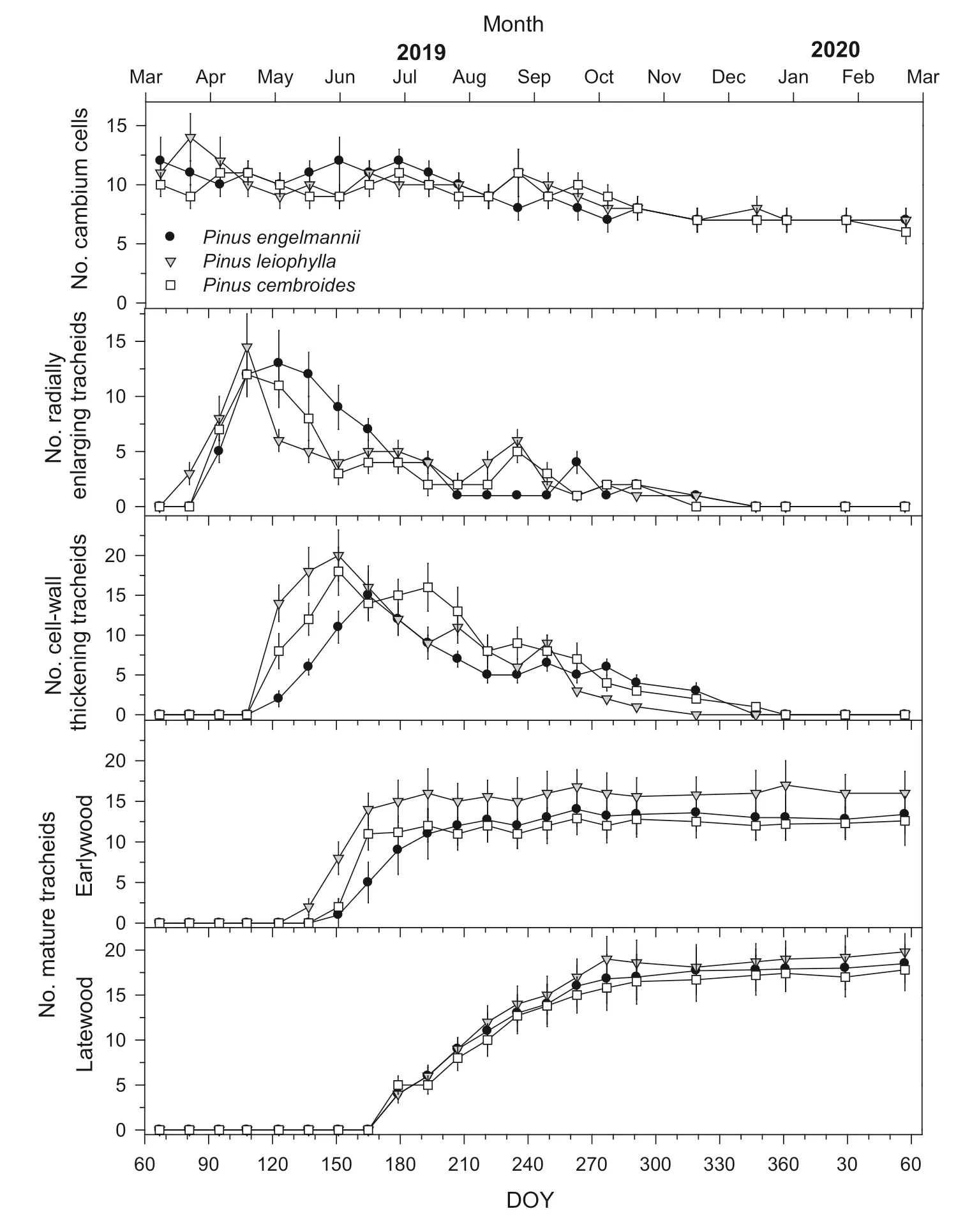
Fig.4 Xylogenesis of the three pine species showing the main phases of xylem development (DOY,day of the year).Values are means ± standard errors
Xylogenesis of Q.grisea
Cambial reactivation was observed from late March to early April (Fig.5).Most trees (80-100%) showed the enlargement of earlywood vessels in early April when the maximum radial increment rate 0.014 mm d-1was observed.The onset of earlywood vessel maturation started in May and was observed in all trees from late June when earlywood vessel enlargement ceased and the first latewood vessels were detected.
Relationships between climate and xylogenesis in pine species
The number of cambial cells was positively related to the 15-day evaporation and 10-day mean maximum temperature,with the highest correlations inP.engelmannii(Fig.6).The production of radial enlarging tracheids was positively related to the 15-day evaporation data and negatively to the 15-day differences between precipitation and evaporation forP.leiophylla.The thickening of cell walls was positively related to 15-day mean maximum temperature and VPD withthe highest correlations inP.cembroidesandP.engelmannii.The cumulative number of earlywood cells positively responded to the 5-day mean minimum temperature and VPD inP.engelmannii,but negatively to the 15-day differences between precipitation and evaporation inP.leiophylla.The cumulative number of latewood cells was positively correlated with mean minimum temperature and VPD,showing the maximum correlation for 15-day mean minimum temperature values andP.engelmannii.
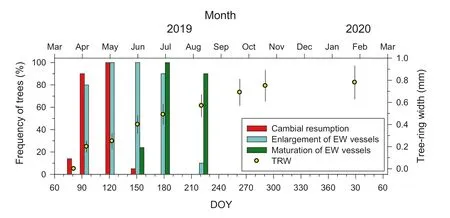
Fig.5 Xylogenesis of Quercus grisea.Values are percentage of trees in each development phase (left y axis,bars) and tree-ring width (TRW) or radial increment (right y axis,means ± standard errors;DOY,day of the year)
Relationships between climate and xylogenesis in Q.grisea
The production of cambial cells was negatively related to the 10-day mean minimum temperature and 15-day VPD values,whereas the enlargement of earlywood vessels was positively correlated with 5 and 15-day mean maximum temperature and evaporation but negatively with differences between precipitation and evaporation (Fig.7).The maturation of earlywood vessels was positively related to 10 and 15-day VPD values.Lastly,radial growth rate was not correlated with climate variables.

Fig.7 Climate-xylogenesis relationships in Q.grisea. The different color bars correspond to 5,10 and 15-day averaged (Tmin and Tmax,minimum and maximum temperatures,respectively;VPD,(vapour pressure def icit) or summed (evaporation;Prec.-Evap.,difference between precipitation and evaporation) climate data.For each climate variable different xylem formation phases or variables were considered:Cam,cambial resumption;Enl,enlargement of vessels;Mat,maturation of vessels;and GR,growth rate;horizontal dashed and dotted lines indicate 0.05 and 0.01 significance levels,respectively
Discussion
It was speculated that differential timings of the main xylogenesis phases and diverse responses to climate would explain coexistence among the tree species.The results support these expectations since the oak showed earlier xylogenesis phases than pines and different responses to climate.
Climate drivers of xylogenesis
Species showing lower climatic constraints for radial cell expansion by water demand such asP.leiophylla,corresponded to those most tolerant to drought,whereas species from wetter sites such asP.engelmanniiandP.cembroidesshowed the highest correlations between wood formation and atmospheric water demand.Overall,15-day wet conditions in spring enhanced cell radial enlargement,particularly inP.leiophyllaandP.engelmannii,whereas early summer 15-day temperatures and VPD drove cell wall thickening in summer inP.cembroides.Tracheid maturation occurred from spring to summer,and was enhanced by high minimum temperatures and VPD,mainly forP.engelmanniiandP.leiophylla.InQ.grisea,earlywood vessel radial enlargement and radial increment peaked in spring and increased as temperature and evaporation increased,whereas vessel maturation from spring to summer was aligned to the rise in vapor pressure def icit.
Seasonal analyses may be compared with tree-ring studies comparing year-to-year climate and growth variability.Bickford et al.(2011) found that growth was enhanced by winter-spring precipitation and that more severe droughts reduced the growth ofP.engelmanniion dry,warm,lowelevation sites.These findings agree with our analyses that xylogenesis inP.engelmanniidepends on water availability.González-Casares et al.(2016) reported thatP.leiophyllagrowth was enhanced by high winter precipitation and cold conditions increasing soil moisture.However,in this study,it was observed that cell radial enlargement in this species was tightly related to 15-day high evaporation rates,suggesting that atmospheric water demand drives cambium division and cell expansion whenever soil moisture was not limiting and cell turgor not reduced.These results agree with recent findings showing the relevance of atmospheric water demand as a driver of radial increment rates rather than soil moisture (Zweifel et al.2021;Etzold et al.2022).However,there were no correlations of xylogenesis phases with vapor pressure def icits except during cell wall thickening,but were positive with temperature which is tightly related to VPD.This discrepancy may be due to the approximate estimates used for calculating VPD or to the fact that the production of new cells was measured in a drought-prone site,whereas Zweifel et al.(2021) measured radial increment rates using dendrometers in temperate,wet forests.
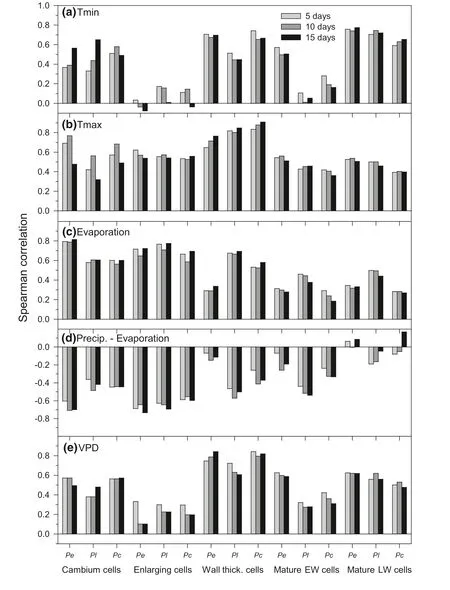
Fig.6 Climate-xylogenesis relationships in the three pine species (Pe,Pl and Pc correspond to P.engelmannii,P.leiophylla and P.cembroides,respectively) considering different xylem formation phases (production of cambium cells,radially-enlarging cells,wall-thickening cells,rates of production of mature earlywood -EW-and latewood -LW-tracheids);different color bars correspond to 5,10 and 15-day averaged or summed climate data;horizontal dashed and dotted lines indicate 0.05 and 0.01 significance levels,respectively
Differences and similarities in xylogenesis among coexisting pine and oak species
Overall,warmer conditions enhanced cambial activity and xylem development in the three pine species and in oak.This suggests a direct relationship between meristematic activity and warmer conditions as described in cold biomes (Rossi et al.2008).Such growth response to warm spring conditions could also influence xylem response to atmospheric water demand,as shown by the direct association between cell enlargement and evaporation observed in the four species.The fact thatP.leiophyllaproduced the highest number of radially enlarged tracheids suggests a greater capacity to use carbohydrates during earlywood formation,possibly linked to adequate soil moisture provided by winter-spring precipitation (Pompa-García et al.2021a).
The thermal and evaporation seasonal regimes influence cell radial enlargement and wall thickening.As the atmospheric water demand keeps rising from spring to summer and soils begin to dry,fast-growing species such asP.leiophyllareduce the production of radially enlarged tracheids.This species showed the latest needle expansion,suggesting the use of recently synthesized carbohydrates for late summer growth (Buttò et al.2020).This would lead to a bimodal growth pattern (cf.Camarero et al.2010).Warmer and drier climates lead to the production of tracheids with narrow lumens slowing down radial enlargement (Vaganov et al.2006).In contrast,P.cembroidesandP.engelmanniihad a lower rate of wood formation but longer xylogenesis,even though earlier needle formation.Such protracted wood phenological patterns could allow these species to tolerate drought by growing during favorable conditions in autumn.
Cell wall thickening,which is a carbon-demanding process (Cuny et al.2015),occurred during the warmest season for the three pines and would explain its positive correlation with vapour pressure def icits.A similar result was observed for earlywood vessel maturation inQ.grisea.TheP.cembroidescell wall thickening phase peaked during the summer solstice,suggesting links with the photoperiod.Thus,although the impact of day length on xylem formation is variable annually,it should be given more consideration (Zhang et al.2018).Summer thermal conditions were favorable for photosynthesis for enhancing cell wall thickening.Although Gao et al.(2021) reported that drought limits the rate of production of cell wall thickening tracheids,it was found that a 15-day vapour pressure def icit was directly related to this xylogenesis phase.High transpiration rates linked to elevated vapour pressure def icits may maintain cell turgor and promote the division of cambial cells and tracheid maturation (Vieira et al.2020).These findings suggest delayed responses of xylem development to climatic conditions,which is consistent with findings from nearby semi-arid sites (Ziaco et al.2016,2018).
InP.engelmanniiandP.cembroides,the rate of cell wall thickening was stimulated by both elevated mean minimum temperatures and vapour pressure def icits,suggesting that radial growth mainly depended on night conditions as reported by Zweifel et al.(2021).This also supports the observation that the demand for atmospheric water is a major promoter of xylogenesis,which is consistent with studies from seasonally dry sites (Vieira et al.2020;Morino et al.2021).A potential association between water demand (VPD),stomatal regulation of water loss and xylogenesis phases (e.g.,cell wall thickening),could explain adaptive mechanisms to tolerate drought (see Garcia-Forner et al.2019).
Growth bimodality in pines:adjusting to seasonal drought
The bimodal growth patterns observed for the three pine species with the post-summer peak of radially enlarging cells forP.leiophyllaandP.cembroides,preceded by approximately a month that ofP.engelmannii,agrees with those found in nearby,seasonally dry forests subjected to summer monsoons (Morino et al.2021;Pompa-García et al.2021a).The higher availability of soil moisture and the decrease in atmospheric demand during monsoon rains reactivates tracheid expansion after the summer drought,resulting in post-summer growth recovery (Morino et al.2021).This is consistent with previous studies in other seasonally dry forests (Camarero et al.2010;Zhang et al.2020;Oberhuber et al.2021).Interestingly,Ziaco et al.(2018) found that the onset of cambial activity after summer drought was associated with increases in humidity prior to the first monsoon rains in the semi-arid southwestern USA,conf irming our findings of the major role of atmospheric water demand as a driver of wood growth.
Growth bimodality may be an adaptation to favorable conditions of atmospheric water demand and soil moisture.Such growth adjustments to seasonal drought can contribute to tree species coexistence,and should be considered when carrying out dendroclimatic reconstructions,since earlywood and latewood production captures different climate impacts on radial growth (Griffin et al.2013;Acosta-Hernández et al.2017).This was confirmed by our study,with earlywood and latewood maturation peaking in spring and in summer,respectively.There are also implications for changes in carbon distribution and hydraulic functioning.For example,the production of tracheids with wide lumens may accelerate hydraulic recovery,whereas latewood production may depend on recently fixed carbon (Garcia-Forner et al.2019).Therefore,forecasted changes in hydrological regimes will mainly affect radial enlargement,which is the most sensitive phase to water shortages and influences annual growth (Cuny et al.2015).In our study site,P.leiophyllahad the highest production of mature earlywood cells,suggesting that growth was adjusted to climate conditions and a low response to spring thermal conditions and atmospheric water demand.In contrast,the production of earlywood and latewood tracheids inP.engelmanniiwas dependent on changes in mean minimum temperatures.
Oak growth patterns and responses to climate
Although several studies have examined ring-and diffuse-porousQuercusspp.under seasonally dry conditions in Mediterranean forests (Corcuera et al.2004a,2004b;Gutierrez et al.2011;González-González et al.2014;Pérez-de-Lis et al.2016),this study reports for the first time the responses byQ.griseain a semi-arid,monsoonal region.Wet conditions in spring induce the cambial activation of this species,whereas high evaporation triggered radial enlargement of earlywood vessels during spring and summer.The maturation of these cells peaked in summer when vapour pressure deficit and photoperiod increased (Fonti et al.2010).This xylogenesis pattern contributes to its high drought tolerance and allows its coexistence with pines (Cavender-Bares 2016).It is suggested that the oak could outcompete the pine species by growing during dry periods with elevated vapour pressure deficits through the uptake of deep soil water (Del Castillo et al.2016).However,the effects of extreme hot and successive droughts could lead to legacy effects on growth (Anderegg et al.2015;Szejner et al 2020).The interactions are highlighted between spring temperatures and summer droughts and their influence on atmospheric water demand that strongly influence conifer resilience in drought-prone environments (Ren et al.2019),whereas oak species appear to be more drought tolerant and may show a faster post-drought recovery.Different durations of drought and recovery periods could also contribute to pine-oak coexistence and should be further investigated.
Conclusions
Our results provide a unique study of xylogenesis in four species coexisting in a mixed pine-oak forest under semiarid conditions,providing new insights on how trees face intra-annual climate variability in areas of marked drought seasonality.It was shown that species differentially responded to climate contributing to their coexistence.In general,warm night conditions and high evaporation rates during spring and summer enhanced xylem formation,but pine species showed more response than the oak.The species with the highest growth rate wasP.leiophyllawhich had an early start of radial growth but a shorter xylogenesis thanP.cembroidesandP.engelmannii.A lower second growth peak was in August and September,corresponding to a bimodal pattern,and attributed to a decrease in evaporative demand and an increase in soil moisture after summer monsoon rains.Temperature played a critical factor as a climate driver of xylogenesis in semi-arid forests,despite the rate,timing,and duration of xylogenesis phases among coexisting species.The capacity of each species to adjust to climate variability determines their vulnerability or resilience to tolerate hotter droughts forecasted under warmer climate scenarios.
AcknowledgementsWe thank Marco González-Cásares,Andrea Acosta-Hernández,José Luis Gallardo-Salazar,Eduardo Vivar-Vivar and José Alexis Martínez Rivas for their support during field work.
FundingOpen Access funding provided thanks to the CRUE-CSIC agreement with Springer Nature.
Open AccessThis article is licensed under a Creative Commons Attribution 4.0 International License,which permits use,sharing,adaptation,distribution and reproduction in any medium or format,as long as you give appropriate credit to the original author(s) and the source,provide a link to the Creative Commons licence,and indicate if changes were made.The images or other third party material in this article are included in the article’s Creative Commons licence,unless indicated otherwise in a credit line to the material.If material is not included in the article’s Creative Commons licence and your intended use is not permitted by statutory regulation or exceeds the permitted use,you will need to obtain permission directly from the copyright holder.To view a copy of this licence,visit http://creat iveco mmons.org/l icen ses/by/4.0/.
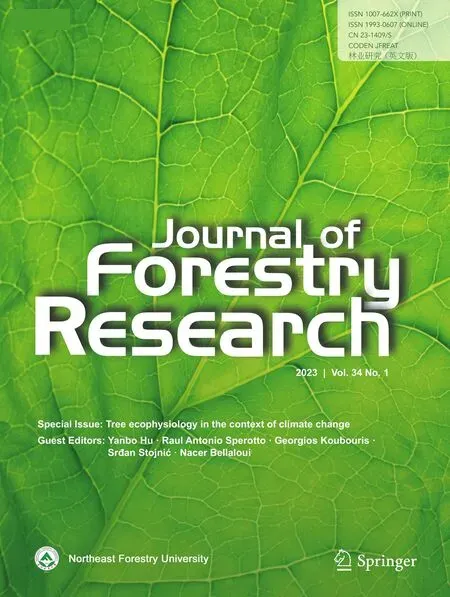 Journal of Forestry Research2023年1期
Journal of Forestry Research2023年1期
- Journal of Forestry Research的其它文章
- Hormetic effects of abiotic environmental stressors in woody plants in the context of climate change
- Epigenetic modification associated with climate regulates betulin biosynthesis in birch
- Growth trends and environmental drivers of major tree species of the northern hardwood forest of eastern North America
- Interannual dynamics of stemwood nonstructural carbohydrates in temperate forest trees surrounding drought
- Allocation patterns of nonstructural carbohydrates in response to CO 2 elevation and nitrogen deposition in Cunninghamia lanceolata saplings
- Different hydraulic strategies under drought stress between Fraxinus mandshurica and Larix gmelinii seedlings
